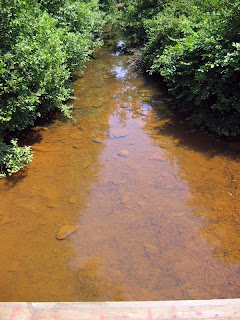Satellite Image Of Chlorophyll-a In Lake Harris
 Above is a satellite-based spectrophotometric image of Lake Harris in Randolph County, Alabama. From the upper left flows the Tallapoosa River, and from the right is the Little Tallapoosa River, all damned to form the lake. What this shows is a very high nutrient level in both tributary rivers and the lake itself, as indicated by high levels of suspended chlorophyll pigments in the water from the presence of one-celled algae.This is especially striking since it was made in April, before typical algal blooms begin. Thus it's a good illustration of how polluted from excess nutrients this river system has become. And it's a graphic illustration of how strongly altered these streams are now, and a measure of what bad habitat they've become for a fish species like the stippled studfish that required clear, low-nutrient water. Our field research indicates that the stippled studfish is found only in tributaries to the Tallapoosa downstream from this lake. The lake may serve a useful purpose as a nutrient sink, trapping much of the crapola in the rivers as they flow out of Georgia.
Above is a satellite-based spectrophotometric image of Lake Harris in Randolph County, Alabama. From the upper left flows the Tallapoosa River, and from the right is the Little Tallapoosa River, all damned to form the lake. What this shows is a very high nutrient level in both tributary rivers and the lake itself, as indicated by high levels of suspended chlorophyll pigments in the water from the presence of one-celled algae.This is especially striking since it was made in April, before typical algal blooms begin. Thus it's a good illustration of how polluted from excess nutrients this river system has become. And it's a graphic illustration of how strongly altered these streams are now, and a measure of what bad habitat they've become for a fish species like the stippled studfish that required clear, low-nutrient water. Our field research indicates that the stippled studfish is found only in tributaries to the Tallapoosa downstream from this lake. The lake may serve a useful purpose as a nutrient sink, trapping much of the crapola in the rivers as they flow out of Georgia.I'd like to thank Prof. Han at the University of Alabama in Tuscaloosa for preparing this image.




